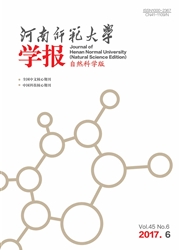

 中文摘要:
中文摘要:
利用密度泛函理论计算了14种HIV抑制剂的4H-甲基咪唑苯二氮(TIBO)的分子性质。利用主成分分析(PCA)和聚类分析(HCA)减少了子变量的个数,从而使这些变量能有效地对抗HIV活性的4H-甲基咪唑苯二氮TIBO衍生物进行分类。主成分分析法表明,EH OMO、μ、LogP、Q A、QB和MR参数能够有效地把所研究的药物分为活性强的抗HIV病毒药物和活性弱的抗HIV病毒药物。聚类分析方法得到的结果与主成分分析得到的结果类似。为了检验结论是否正确,利用化学计量学方法,使用主成分分析法和分层聚类分析法对其他4个抗HIV活性的合成化合物进行了分析,其中3个被认为是活性强的抗HIV病毒药物,这与临床试验结果一致。主成分分析法和分层聚类分析法为新的抗HIV病毒的TIBO药物的分类提供了一个可信的规律。
 英文摘要:
英文摘要:
Density functional theory (DFT) was used to calculate a set of molecular descriptors (properties) for 14 TIBO derivatives with anti-HIV activity. Principal component analysis (PCA) and hierarchical cluster analysis (HCA) were employed in order to reduce dimensionality and investigate which subset of variables should be more effective for classifying TIBO derivatives according to their degree of anti-HIV activity. The PCA showed that the EHOMO,μ, LogP, QA, QB and MR variables can effectively separate the compounds under study with higher and lower anti-HIV activity. The HCA results are similar to those obtained with PCA. By using the chemometric results, four synthetic compounds were analyzed through PCA and HCA and three of them are proposed as active molecules against HIV, which is consistent with the results of clinic experiments. The methodologies of PCA and HCA provide a reliable rule for classifying new TIBO derivatives with anti-HIV activity.
 同期刊论文项目
同期刊论文项目
 同项目期刊论文
同项目期刊论文
 The solvent and substituent effects on bond dissociation energies of NO-donor molecules containing t
The solvent and substituent effects on bond dissociation energies of NO-donor molecules containing t Theoretical investigation of the elastic, electronic, thermodynamic and optical properties of the zi
Theoretical investigation of the elastic, electronic, thermodynamic and optical properties of the zi The spectroscopic, NMR analysis of 1-(2,6-Dichloro-4-nitrophenyl)-5-amino-4-cyanopyrazole by ab init
The spectroscopic, NMR analysis of 1-(2,6-Dichloro-4-nitrophenyl)-5-amino-4-cyanopyrazole by ab init Theoretical studies on heats of formation of pyride N-oxides using density functional theory and com
Theoretical studies on heats of formation of pyride N-oxides using density functional theory and com Molecular structure, IR spectra of 2-mercaptobenzothiazole and 2- mercaptobenzoxazole by density fun
Molecular structure, IR spectra of 2-mercaptobenzothiazole and 2- mercaptobenzoxazole by density fun Pseudo-potential investigations of structural, elastic and thermal properties of tungsten disilicide
Pseudo-potential investigations of structural, elastic and thermal properties of tungsten disilicide Numerical exploration of population transfer of Rydberg-atom by single frequency-chirped laser pulse
Numerical exploration of population transfer of Rydberg-atom by single frequency-chirped laser pulse Theoretical study of the N-NO2 bond dissociation energies for energetic materials with density funct
Theoretical study of the N-NO2 bond dissociation energies for energetic materials with density funct 期刊信息
期刊信息
